 An Open Letter from Jewish Students at Columbia
An Open Letter from Jewish Students at Columbia
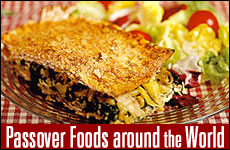

4 min read
11 min read
8 min read
22 min read
Fresh, intensely flavorful Passover recipes from different Jewish communities.
Different Jewish communities around the world prepare fresh, intensely flavorful recipes on Passover. Try some of these traditional dishes to spice up your own meals this Passover!
Charoset
Charoset, the paste that symbolizes the mortar our ancient Jewish ancestors used in slavery in ancient Egypt, is present on Seder tables the world over. Yet did you know that Jewish communities around the world prepare very different versions?
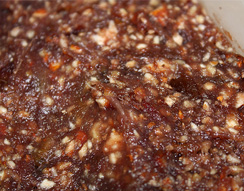 Here is a delicious Turkish version:
Here is a delicious Turkish version:
Grind (or chop in a processor or blender) all the fruits together. Moisten with juice or wine, and stir in nuts.
Makes about 1 ½ cupsRecipe from Sephardi Israeli Cuisine: A Mediterranean Mosaic by Sheilah Kaufman (Hippocrene Books 2002).
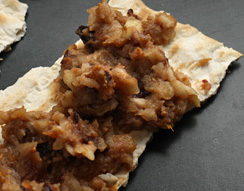 And here is an unusual Syrian version:
And here is an unusual Syrian version:
Put the dates I a medium saucepan with enough water to cover them. Bring to a boil, lower the heat, and simmer, stirring frequently, until the dates are soft.
Pass the date mixture through a strainer or rotary grater. A food processor may also be used, mixing in 3-4 batches for 30 seconds at a time. Refrigerate.
Before serving, add the wine, cinnamon, and walnuts if desired, and mix thoroughly.
Yield: 20 servings.
Recipe from Aromas of Aleppo by Poopa Dweck (HarperCollins 2007).
Hallaq
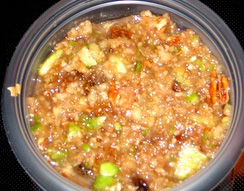 Persian Jews make Halegh for their Seder tables instead of Charoset. To symbolize the forty years in which the Jews wandered in the desert after leaving Egypt, many cooks use a variety of each type of fruit (using several different color apples for instance, or different varieties of pears or raisins) so the number of ingredients in their Hallaq equals forty.
Persian Jews make Halegh for their Seder tables instead of Charoset. To symbolize the forty years in which the Jews wandered in the desert after leaving Egypt, many cooks use a variety of each type of fruit (using several different color apples for instance, or different varieties of pears or raisins) so the number of ingredients in their Hallaq equals forty.
In a large food processor, combine nuts, raisins, dates and spices. Pulse until nuts are coarsely chopped.
Add apple, pear and bananas, and pulse until coarse chop. Add 2T vinegar, ½ cup pomegranate juice, and ½ cup wine. Pulse again, adding more vinegar, juice or wine to taste, as needed to make a coarse paste. Do not puree; mixture should retain some crunch.
Makes 6 cups.
Recipe adapted from http://www.nytimes.com/2010/03/24/dining/24passoverrex1.html
Matzah Balls
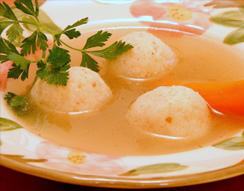 Here’s an easy recipe for the classic Ashkenazi Passover accompaniment to soup. It’s traditional to serve matzah balls in chicken soup, though they’re delicious in vegetable soup too.
Here’s an easy recipe for the classic Ashkenazi Passover accompaniment to soup. It’s traditional to serve matzah balls in chicken soup, though they’re delicious in vegetable soup too.
Bring salted water to a boil. While you are waiting for water to heat, mix matzoh ball dough.
Combine eggs, oil, salt and pepper. Then mix in matzoh meal, a little at a time, until the mixture is thickened but still sticky. Matzoh meal absorbs lots of water, so wait 10 minutes or so to see if you need more. Aim for your batter to feel like modeling clay.
Wet your hands and roll batter into balls; for large balls, roll them into the size of a small egg. For smaller balls, aim for walnut-sized. Drop balls into the boiling water, then reduce heat and simmer for at least 30 minutes.
(For a Polish version, add a couple drops of almond extract to matzoh ball dough. If you do this, you might also want to form each ball around a single skinless almond; it is a fancy, nice touch.)
Makes approx. 12 small matzoh balls.
Recipe from Angels at the Table: A Practical Guide to Celebrating Shabbat by Yvette Alt Miller (Continuum 2011).
Minestra Dayenu
This unusual soup is a traditional Passover soup of the Jewish community of Turin, in Italy. “Dayenu” means “it would have been enough”, and it forms the chorus of a beautiful song in the Hagaddah, thanking G-d for taking us out of slavery in Egypt.
Bring the chicken stock to the boil, throw in the matzo pieces, and simmer ½ hour, until the matzo is very soft and bloated. In a soup tureen, beat the egg yolks with the cinnamon and 4-5 T of cold water, then gradually pour in the soup, stirring constantly.
Serves 6
Recipe from The Book of Jewish Food by Claudia Roden ( Alfred A. Knofp 1996).
M’Soki
 Among Tunisian Jews, M’soki, is a Passover favorite. This is a heart, soupy stew that incorporates two Passover food themes: vegetables and lamb.
Among Tunisian Jews, M’soki, is a Passover favorite. This is a heart, soupy stew that incorporates two Passover food themes: vegetables and lamb.
Passover is sometimes called the Spring Festival, and many communities eat colorful vegetables to stress this theme. Lamb recalls G-d’s instructions to the Jewish slaves in Egypt to sacrifice and eat a meal of sheep the night before the Exodus from Egypt. This delicious stew also contains artichokes, a Spring vegetable that is closely identified with Passover in Sephardi Jewish cooking.
Heat the vegetable oil in a large soup pot or Dutch oven. Season the lamb, and two beefs with salt and pepper to taste, and brown in batches on all sides. Remove from the pot. Then toss into the pot the fennel, carrots, onions, and sauté, scraping up any bits of meat that have stuck to the bottom. Season with salt and pepper to taste, and cook until slightly softened. Add the spinach and beet tops, and cook until wilted.
Return the browned meat to the pot, and barely cover with cold water. Bring to a boil, cover and cook over medium-high heat for 30 minutes.
Add the artichoke bottoms, cilantro, mint and nutmeg. Lower the heat so that the soup is barely simmering, and cook for 2 more hours, or until the meat is very tender, adding water if needed.
Cut the meat into 1-inch pieces, discarding any bones, and put it back into the soup. Just before serving, break up the matzos into six pieces each. Soak them in salted water until slightly moistened, then press out the water. Serve the soup garnished with the reserved cilantro and mint and the matzo pieces.
Serves 10-12.
Recipe adapted from Quiches, Kugels and Couscous: My Search for Jewish Cooking in France by Joan Nathan (Alfred Knopf 2010).
Anjinaras
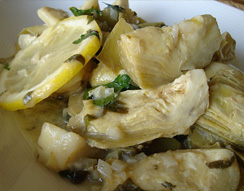 Here is another traditional Passover recipe – from the Jewish community of Turkey – that also features artichokes: a Spring vegetable closely identified with Passover.
Here is another traditional Passover recipe – from the Jewish community of Turkey – that also features artichokes: a Spring vegetable closely identified with Passover.
Slice off the woody stems of the fresh artichokes. Tug off the tough outer leaves. Turn each artichoke on its side and slice off about 1 inch from the top, exposing the pale interior. Nip off the spiny points of the remaining leaves. Quarter each artichoke and remove the hairy choke from the center. Add the quarters to the bowl of water in which you have placed the lemon shells.
In a large pot, bring a quart of water to a boil with the honey, lemon juice, and oil. Add the artichokes, lower the heat, and cook, covered, for 40-45 minutes for fresh artichokes, or until tender but not mushy. Frozen artichokes, which need not be defrosted, will cook in 6-8 minutes.
With a slotted spoon, transfer the artichokes to a serving bowl. Combine with the shallots. Boil down the cooking liquid until it is syrupy and reduced in volume to about ½ cup. Pour this liquid over the artichokes. Let cool to room temperature and serve sprinkled with the parsley.
Serves 6-8.
Recipe from The Passover Table by Susan R. Friedland (David Barich & Assoc. 1994).
Carciofi all Giudia (“Jewish Style Artichokes”)
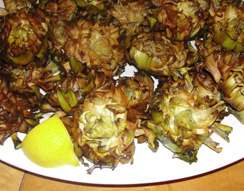 Italian Jewish cookbook author Edda Servi Machlin remembers that growing up, no matter what else was on the menu, Passover dinner always included artichokes, a Spring vegetable often served in Sephardi communities on Passover. Passover is often called “Chag Ha-Aviv”, or the Spring Holiday, making artichokes the perfect way to celebrate.
Italian Jewish cookbook author Edda Servi Machlin remembers that growing up, no matter what else was on the menu, Passover dinner always included artichokes, a Spring vegetable often served in Sephardi communities on Passover. Passover is often called “Chag Ha-Aviv”, or the Spring Holiday, making artichokes the perfect way to celebrate.
This delicious artichoke dish, often served on Passover, is the most famous of all Italian Jewish foods.
Trim the artichokes as described above and keep them in lemon water until you are ready to cook them.
Drain two artichokes, and, holding one in each hand by the stem and bottom, gently hit the leafy parts against each other until the leaves of one artichoke open up a little. Place the opened artichoke, bottom up, in a board or a working surface. Continue with remaining artichokes.
In a small bowl, combine the salt and pepper. Take one artichoke at a time and sprinkle all over, including between the leaves, with the salt and pepper mixture.
Heat the oil in a deep earthenware or similar saucepan. Cook as many artichokes at a time as fit in one layer over moderate heat for 20-25 minutes, or until the bottoms and sides are well browned. During this cooking period, sprinkle some cold water over the artichokes to produce steam, so that the inside will be cooked too.
When all the artichokes are done, transfer them to a plate, bottom side down, to keep the moisture in. (Up to this point you may prepare the artichokes several hours ahead of time and keep them, bottom side down, so they don’t lose their moisture. Should they become too dry, sprinkle some cold water on them when reheating and press the leaves down against the bottom of the pan.)
Pick them up at the bottom with a fork and dip them, one by one, in the hot oil again, pressing the leaves to the bottom of the pan. The artichokes will open up like roses and the leaves will become golden and crisp.
Serves 6.
Recipe from Classic Italian Jewish Cooking by Edda Servi Machlin (Ecco 2005).
Mina de Pesach
 Sephardi Jewish communities enjoy layered pies on Passover, called “minas”. The fillings of these vary widely; here is a luscious version with chicken and mushrooms that can be served as a main course.
Sephardi Jewish communities enjoy layered pies on Passover, called “minas”. The fillings of these vary widely; here is a luscious version with chicken and mushrooms that can be served as a main course.
Preheat oven to 375 F. Have ready a baking dish approximately 10x8x2 inches – a foil one is excellent.
The chicken can be leftovers or chicken-breast meat poached with a bay leaf or microwaved (covered with water and a bay leaf) until tender. Cut the chicken into strips about ½ x 1 ½ inches.
Sauté the finely chopped onion in the fat until soft and golden, then add the thinly sliced mushrooms and sauté until tender – another 5 minutes. Allow to cool while you beat the eggs until blended, then stir in the mushroom and chicken mixture, ½ t of the salt and the pepper and chopped herbs.
Make up 1 ¼ cups of chicken stock or use leftover chicken soup or the poaching liquid.
Heat the oil in a small pan for 3 minutes, then pour 2 t into the baking dish and swirl it round to coat both the bottom and sides. Dip 2 of the matzot into the stock (or chicken poaching liquid) until well moistened, then lay side by side in the baking dish. Spoon half the egg mixture on top, cover with 2 more moistened matzot, then the remaining egg mixture and finally rthe 2 remaining matzot, also moistened.
Pour half the remaining oil over the top and bake for 15 minutes, then sprinkle with the remaining oil and bake a further 10-15 minutes until a rich crisp brown. Cool for 10 minutes, then serve in squares.
Serves 4-5
Recipe adapted from The New Complete International Jewish Cookbook by Evelyn Rose (Robson Books 2000).
Megina
Jewish communities in Turkey, Greece and Rhodes cooked their own version of matzoh pies, called Megina.
Preheat the oven to 375 F. With a little of the oil, grease a 13 inch baking dish with a capacity of about 3 ½ quarts.
Heat the remaining oil in a skillet and sauté the onions until they soften. Add the meat and, stirring, sauté until it is browned and all the clumps have broken up. Remove from the heat and pour off some of the accumulated fat. Add the herbs and taste for salt and pepper.
Beat 2 of the eggs just to combine the yolks and whites and add them to the meat.
In a pie plate or the skillet in which you cooked the meat, soak the whole matzos briefly in warm water, just until they soften and before they fall apart. Drain on paper towels.
Beat the remaining eggs just to combine. Place in the wiped-dry pie plate. Carefully dip 2 softened matzos into the eggs. Line the prepared pan with them, breaking the matzos into pieces to fit. Evenly spread the meat mixture over the matzos.
Soak the remaining matzos in the eggs and cover the meat with them. Pour any remaining egg over the matzos.
Bake for 30-45 minutes, or until a rich brown crust forms. Cut into wedges and serve hot.
Serves 6-8
Recipe from The Passover Table by Susan Friedland (HarperPerennial 1994).
Masalachi Mutton
The ancient “Bene Israel” Jewish community living in Cochin, in India, traces its origin to a shipwreck that left seven Jews stranded on the Indian coast two thousand years ago. They kept their Jewish traditions, though their cooking picked up a distinctly Indian flavor through the millennia.
This Bene Israel Passover dish incorporates lamb, recalling the original Passover sacrifice in ancient Egypt.
Finely mince cilantro, ginger and green chilies, using a food processor if desired. Heat oil in a large, heavy pan over medium-high heat. Sauté onions until lightly browned, about 15 minutes. Add cilantro mixture and tomato puree and continue cooking until tomatoes lose raw fragrance, about 5 minutes.
Stir in bay leaves, turmeric, cinnamon, black pepper and cayenne pepper. Add lamb and salt, mix well and bring contents to a boil.
Lower heat, cover and simmer gently until fork-tender, about 1 ½ hours, stirring frequently. Add water as necessary.
Makes 8 servings.
Recipe adapted from http://articles.latimes.com/1991-03-24/food/fo-1509_1_coconut-rice
Boumuelos
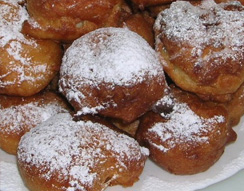 These fritters were served for breakfast after the first Seder in Bulgaria.
These fritters were served for breakfast after the first Seder in Bulgaria.
Break the matzo in small pieces, and soak overnight. In the morning, squeeze out as much of the water as possible.
Prepare sugar syrup by boiling sugar and 1 ½ cups water together, cooking and stirring for 10 minutes. Set syrup aside.
In a large bowl mix together the matzo, eggs and salt.
Heat enough oil in a frying pan or electric fryer to cover the bottom. Drop mixture by teaspoonfuls or tablespoons into a round shape. Fry and turn until brown on both sides, then drain well on paper towels.
Serve with the hot sugar syrup.
Makes 12-15 large boumuelos.
Recipe from Sephardic Israeli Cuisine: A Mediterranean Mosaic by Sheilah Kaufman (Hippocrene 2002).
Matzah Meal and Cottage Cheese Latkes
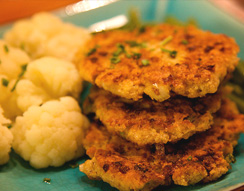 In Russia, this was a popular breakfast on Passover.
In Russia, this was a popular breakfast on Passover.
In a bowl, mash the cottage cheese. Mix in the egg yolks, half the salt, the matzo meal, onion, sugar, yogurt or water, and pepper.
Whisk the egg whites with the remaining salt until stiff. Fold one-third of the whisked egg whites into the batter, then fold in the remaining egg whites.
Heat the oil in a heavy frying pan to a depth of about ½ inch, until a a slice of matzah added to the pan turns brown immediately. Drop tablespoonfuls of the batter into the pan; fry over a medium-high heat until the undersides are golden brown. Turn carefully and fry the second side.
When cooked, remove the latkes from the pan with a slotted spoon and drain on kitchen paper. Serve immediately or place on a baking sheet and keep warm in the oven.
Variations: to make sweet latkes, omit the onion and add 1-2 T sugar, chopped nuts and some ground cinnamon. Serve topped with a spoonful of jam or honey.
Makes about 20.
Recipe from Jewish Food for Festivals and Special Occasions by Marlena Spieler (Southwater 2003).
Apere di Pesach
These unusual pastries are a specialty of the Jewish community in Venice. At its peak, during the Renaissance, the Jewish community in Venice numbered several thousand. Confined to an enclosed island (called the “Ghetto”, the origin of the term), the Venetian Jews nonetheless managed to produce an incredibly rich intellectual, artistic, religious, and culinary culture.
Beat the eggs with the sugar, anise extract, and lemon rind. Gradually add enough flour to form a not too loose batter.
Spoon over a nonstick baking sheet, holding the spoon vertically to obtain round medallions. Bake in a preheated 300 F oven for 10 minutes, or until the cookies are lightly golden. Let cool on the baking sheet at room temperature before storing in a clean white pillowcase.
Yields approx. 48 cookies.
Recipes from Classic Italian Jewish Cooking by Edda Servi Machlin (HarperCollins 2005).
Torta di Datteri
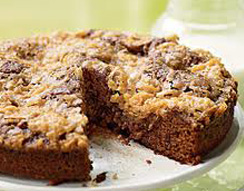 The Jewish community in Livorno, in Italy, long had an ancient trading connection with Tunis. There is a Tunisian influence in this classic Livornese Passover cake.
The Jewish community in Livorno, in Italy, long had an ancient trading connection with Tunis. There is a Tunisian influence in this classic Livornese Passover cake.
Thoroughly mix all the ingredients. Line a 9” cake pan with greaseproof paper or use a nonstick springform cake pan, rubbed with oil and dusted with Passover cake flour or matzah meal. Pour in the cake mixture and bake in a preheated 350 F oven for about 45 minutes.
Serves 10
Recipe from The Book of Jewish Food by Claudia Roden (Alfred A. Knopf 1996).
Coconut Macaroons
 Macaroons originated in Naples, where there name, maccarone, meant “fine paste”. During the Renaissance, Catherine de Medici’s chef visited France, where he shared these confections, and started a French craze for Macaroons.
Macaroons originated in Naples, where there name, maccarone, meant “fine paste”. During the Renaissance, Catherine de Medici’s chef visited France, where he shared these confections, and started a French craze for Macaroons.
These are popular with French Jews, and Jews around the world.
Preheat oven to 325 F. In a bowl, toss the coconut, sugar and salt. Add the egg whites and work them in with a wooden spoon to form a dough.
Take heaping teaspoons of dough and shape them into balls. Place on a lightly greased cookie sheet. If desired, place a piece of garnish on top of each ball.
Bake for about 20 minutes or until lightly browned. Let cool for 5 minutes, then remove the macaroons to a cake rack to cool completely.
Makes about 20.
Recipe from Hip Kosher by Ronnie Fein (DaCapo 2008).
Gato de Muez de Pesach
This is a classic Passover dessert from Istanbul.
Beat the egg yolks with the sugar til light and pale. Add the ground almonds, then the orange juice and rind and the walnuts. Mix very well.
In a separate bowl, beat the egg whites stiff, and fold into the nut mixture. Oil a preferably nonstick springform 9” (23 cm.) cake pan and dust with matzoh meal. Pour in the cake mixture and bake for 1 ½ hours in a preheated 350 F oven. Garnish with orange slices, if desired.
Serves 10.
Recipe adapted from The Book of Jewish Food by Claudia Roden (Alfred A. Knopf 1996).
Tuscan Matzah Cake
Jews have lived in Italy’s Tuscan region since Roman times. Here is an unusual Passover cake from Tuscany.
Soak matzo in water until soft. Place the sugar with 1 T water and cinnamon in a small pan and boil until the sugar is dissolved.
Drain the matzo, squeeze the Water out with your hands, and place in a bowl. Add the egg yolks, the sugar-cinnamon syrup, and the lemon rind and mix well.
Beat the egg whites until stiff and dry, and fold into the matzo batter. Spoon into a greased 8” springform baking pan and bake in a preheated 300 F oven for 45 minutes or until a skewer inserted in the center comes out clean.
Unmold upside down and let cool to room temperature. Serve sprinkled with:
Vanilla-Flavored Sugar
Place sugar and vanilla beans into an airtight glass jar and set aside at room temperature for at least 2 weeks before using.
Cake serves 6. Sugar recipe yields 2 cups.
Recipes from Classic Italian Jewish Cooking by Edda Servi Machlin (HarperCollins 2005).
Spanish Sponge Cake
 Sponge cake is a classic Passover dessert, with roots in the Spanish Jewish community. Here is an easy, foolproof version, with a subtle Oriental flavor.
Sponge cake is a classic Passover dessert, with roots in the Spanish Jewish community. Here is an easy, foolproof version, with a subtle Oriental flavor.
Preheat the oven to 350 F. Lightly grease an angel food or 10” tube pan and dust it with potato starch.
Place the egg whites over a bowl of warm water and allow them to stand for a couple of minutes to warm (or leave them at room temperature for 20-30 minutes).
Meanwhile, sift together the cake meal, potato starch, and ¼ t salt. Set aside.
In one bowl, briskly whisk together the egg yolks, ½ cup of the sugar, the vanilla sugar, orange and lemon zest, and lemon or orange juice. Stir in the cake meal and potato starch and combine well.
In a mixing bowl, with clean, dry beaters, whisk the egg whites and salt together until frothy. At high speed, whip, slowly dusting in the remaining sugar, until the whites are stiff and glossy.
Mix one third of the whipped egg whites into the yolk mixture to lighten and aerate it. Then gently fold in the remaining whites, in 2 batches, to incorporate but not deflate the whites.
Gently pour the batter into the prepared pan and place in the oven. After 10 minutes, reduce the heat to 325 F and bake until done (30-45 minutes) or until the cake seems just firm when lightly touched.
Cool the pan by inverting onto a large plate. Cake will eventually unmold itself without losing much of its height this way.
Variation I: with the matzoh meal, add 1 t ground cinnamon, ½ t ground cloves, ¼ t each grated nutmeg, ginger, and ground mace or allspice. You may also use brown sugar instead of white.
Variation II: replace the orange or lemon juice with sweet, red, kosher wine. Add ½ cup finely ground toasted nuts with the cake meal and potato starch, or sprinkle the top of the unbaked cake with 2 t sugar and ¼ cup sliced almonds.
Makes 8-10 servings.
Recipe from A Treasury of Jewish Holiday Baking by Marcy Goldman (Doubleday 1998).
